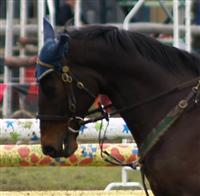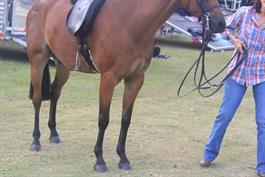Equine health and care course
Learn more about maintaining and improving the health of horses!

Course Structure and Content
This course has six lessons:
1. Blankets, Bandages & Boots
- Different blankets and rugs
- Fitting a rug
- Surcingles and rollers
- Caring for rugs and blankets
- Types of bandages and their uses
- Rules for bandaging
- Boots and their uses
2. Maintaining The Health of Horses
- Signs of good and poor health
- Sick nursing rules
- Isolation procedure
- Recognising common ailments
- Taking the temperature
- The medicine chest
- First aid treatments
- Restraining a horse
- Emergencies
- Preventing a disease
3. Clipping, Trimming & Plaiting
- Reasons for clipping
- Types of clippers
- Types of clips
- Preparation for clipping
- How to clip
- Finishing off
- Hogging the mane
- Trimming
- Pulling the mane and tail
- Plaiting the mane or tail
4. Travelling & Care of the Horse away from Home
- Preparing a horse for travel
- Preparing a trailer
- Loading the horse
- The problem loader
- Safety while loading
- Before a show
- At the show
- Returning home
5. Organising & Managing a Horse Event
- Organising an event
- Contingencies to cater for
- The public, exhibitors and organisers
- Costs
- Guidelines for planning a show or exhibition
- The facility
- Exclusive bookings
- Facilities without prior bookings
- Booking records
- Publicity
- Community participation
6. Managing a Horse Enterprise
- Management plans
- Rural finance sources
- Banks
- Money market
- Financial planning
- Contract law
- Assessing profit
- Risk analysis
- Standards
- Financial records
- Cash flow
- EOP accounting
There is an assignment at the end of each lesson to submit to your tutor for feedback and marking. You can also contact your tutor with any questions throughout the course.
Aims
- Identify the use and purpose of protective equipment for horses, including blankets, bandages and boots.
- Determine the procedures required to maintain a horses health.
- Develop a program to prepare a horse for showing.
- Prepare a management plan for a horse while away from it's home.
- Develop a plan for the management of a horse industry event.
- Analyse the management of a horse enterprise, including its marketing and financial viability.
How well do you understand horses?

Horses are naturally gregarious creatures who instinctively feel safe in numbers. This results in a very strong desire to stay within the herd. It is not ideal or natural to keep a horse alone.
It can be stressful for a horse to be separated from the other members of his herd or group as this will cause him to feel threatened.
Horses left in their stables when all the others leave the yard to go out on exercise or into the field, may become very upset. Pacing, whinnying loudly and sweating are common reactions. In extreme cases they may try to actually jump out of the stable.
The stable yard can also become a substitute for the safety of the herd. This may explain why horses tend to walk out more freely and are less likely to nap on the way home from a hack, as they are keen to get home. A frightened horse instinctively returns to his stable if they break loose or when their rider has fallen off.
This sense of security can be dangerous in the event of a fire. The horse smells and hears burning and is afraid. The stable represents a safe place and won’t want to leave. To overcome this, the horse will often need to be disorientated by covering their eyes with a jacket or towel before they will allow themselves to be led to safety.
Signals of Communication
Living successfully and peacefully in groups depends on using the rights signals as well as understanding the signals given by others.
Some signals are discrete such as the presence or absence of an individual’s scent on an object. Others are more obvious and graded on an escalating scale of threats from laying ears back to a full blown double barrel kick with the hind legs.
The medium used to transmit the signal is likely to be the one most appropriate to the type of message being conveyed. Auditory, chemical, tactile and visual mediums are all of great importance to the horse.
Auditory signals can travel a relatively long distance and allow a rapid exchange of information. They do however require a lot of energy to send and the signaller is easy to identify.
Neighs and whinnies signal an individual’s presence and may be used when a horse is separated or isolated from another such as a foal becomes separated from its mother. Nickers appear to be a sign of encouragement to come nearer. They are used by mares towards foals, stallions when they wish to mate and by either sex when a familiar person is approaching. Squeals are generally believed to be a defensive threat greeting between unfamiliar horses. They usually follow a nose-to-nose exchange and are often accompanied by a backward leap. They may act as a warning of more overt aggression if provoked.
Short snorts are often heard when the horse is alarmed. A more prolonged sound is more often associated with frustration. Groans are usually quite soft and often heard at times of discomfort or tiredness. Occasionally they will be heard from horses that have been confined to their stable for long periods of time. Roars and screams are made at times of extreme arousal. They appear to threaten severe physical violence and occur when more subtle signals have been ignored. Foot stamping and pawing are two other auditory signals which are thought to convey a low-level threat or discomfort and frustration respectively.
Chemical signals travel well but take longer to exchange. The signaller is less easily identifiable and in terms of energy expenditure, the signals are relatively cheap. Humans tend to underestimate the importance of chemical signals due to our relatively poor sense of smell. Horses use both sniffing and the flehmen response in order to investigate social odours or pheromones.
Chemical signals are produced in skin secretions, saliva and probably breath, in addition to the more obvious urine and faeces. Greetings between horses often involve investigation of the nose and mouth, followed by flanks and perineal regions. The latter appears to be particularly important to the foal who will shake its tail as it feeds, wafting its odours to the mare. This may aid in the early development of the bonding process.
Chemical signals may be involved in the following processes:
1. Identification of individuals, including sex, age and physiological state.
2. Coordinating and spacing individuals within a social group.
3. Mare-foal bonding.
4. Navigation and orientation.
5. Sexual arousal and performance.
6. Growth, development and maturity
Tactile signals involve close contact and are easily blocked by physical obstacles. They do allow for rapid exchange of information. The signaller is easily identified. Tactile signals may range from those conveyed during grooming which has a calming effect, to those used in aggression such as biting and kicking which cause excitement.
Visual signals travel a reasonable distance and can offer a rapid exchange of information. The signaller is usually very obvious as they can be seen – although again this signal could be blocked by physical obstacles. Visual signals do not require a lot of energy expenditure.
Sudden or unusual movements are generally quite exciting to a horse and will increase arousal. Such movements are seen in threat displays such as jerking the head forwards and up, striking the foreleg or rearing. This is combined with the appropriate posture. A relaxed horse has a long, extended posture, whereas an excited animal is more gathered like a spring.
Visual signals give an accurate indication of where the horse’s attention is. When a horse notes something new is going on in the environment, depending on the level of arousal it elicits the horse will turn one ear or both ears, the whole head, or the whole body towards the source. Once this source has been identified the horse will then decide on the most appropriate response e.g. run away, stand ground or befriend to defuse the situation. The horse attempts to defuse the situation by a number of different ways. It may throw its head up but keep its eyes on whoever is approaching. The tail is generally tucked between the hind legs as it moves its quarters away. This suggests the horse is mildly fearful but does not pose a threat unless these signals are ignored.
A more obvious cautious approach gesture is for the horse to tuck its tail under, lower its head, turn its ears outward and champ its teeth. This is commonly seen in young horses and appears to signify uncertainty or general anxiety. Humans tend to consider the visual route first and think of the obvious visual signals that horses use in their communication. This is not necessarily the most useful or most developed communication channel.
Why Study with ACS?
Design your own learning pathway.
Study at your own pace, from anywhere, at any time.
Receive prompt, expert support from our team of committed and friendly tutors.
Your learning is our priority. We are flexible and adaptable to meet your educational needs!
Enrolling is easy - just go to the top of this page and select your study method and payment option.
If you have any questions about studying with ACS, or want to know more about any of our courses, get in touch with our specialist tutors today.
They will be happy to answer your questions and look at different study options to fit in with your goals.